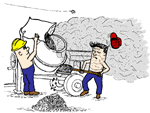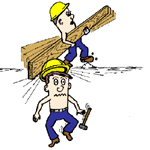|
 |
Safety tips for working with concrete
Working with concrete is an everyday occurrence for tens of thousands of U.S. concrete workers and residential do-it-your-selfers. Few people involved in mixing, handling and finishing concrete experience serious injury.
However, anyone handling concrete for a major project or just a home patio, sidewalk, or driveway, should understand and practice a number of basic safety tips concerning protection, prevention, and common sense precautions. The tips that follow concern protecting your head, back, skin, and eyes.
Protect Your Head
- Wear a hard hat for head protection! Working on a construction site presents a variety of items to avoid that can cause serious head injury. Both construction equipment and tools are frequent potential hazards to concrete contractors and do-it-your-selfers.
Protect Your Back
-
Be careful how you move heavy materials. Working with the normal materials that are required to make and pour concrete such as portland cement, aggregate, sand, and water can be very strenuous to the average person's back. Most of these materials are heavy even in small quantities.
-
Take care to lift properly keeping your back straight and your legs bent to avoid serious back strain.
-
Carry these materials, if you have to, keeping them waist high and centered between your legs to lessen the chance for injury.
-
Ask a co-worker, or a neighbor, for help if you need to lift heavy materials.
-
Use mechanical or manual equipment whenever possible to move materials as close to its final placement area. Use a cement mixer's chute, a concrete pump, or just a wheelbarrow to get the concrete placed.
-
Push the concrete to its final position with a shovel or similar tool. Do not lift the concrete mix.

Protect Your Skin
-
Protect your self from skin irritation and chemical burns when working with fresh concrete. Severe burns can result with on-going contact between fresh concrete and skin surfaces, eyes, and clothing.
-
Get minor burns treated by a physician, if they persist. Seek immediate medical help if burns affect a large area of your skin or appear to be deep.
-
Avoid direct skin contact with sand and aggregate since they are very abrasive to your skin.
-
Don't handle wet cement directly since it is basic so it will be injurious to your skin.
-
Don't handle portland cement without protection since it will draw moisture from your skin.
-
Wear protective clothing, such as waterproof gloves, long-sleeved shirts, and long pants to keep the concrete from making contact with your skin.
-
Ensure the protective clothing stays dry so it does not transfer the alkaline or hygroscopic effects to the skin.
-
Wear rubber boots if you must stand in the fresh concrete while it is being placed, screeded, or floated to prevent concrete from flowing into them and making contact with your lower legs, ankles and feet.
-
Use waterproof pads to protect your skin, knees, elbows, or hands from contact with fresh concrete during finishing.
-
Flush eyes and skin that come in contact with fresh concrete immediately with clean water.
-
Rinse clothing saturated from contact with fresh concrete quickly with fresh water.
-
Wear clean, dry, clothing each work day or for your project.
-
Take a bath or shower at the end of the work day or the conclusion of your do-it-yourself project.
Protect Your Eyes
-
Wear proper  eye protection when working with cement or concrete. Splattering concrete and blowing dust can easily enter your eyes during a concrete placement. eye protection when working with cement or concrete. Splattering concrete and blowing dust can easily enter your eyes during a concrete placement.
-
Wear full cover goggles or safety glasses with side shields, depending on the conditions at your project.
Concrete is an essential component to U.S. construction and we will be using it for the foreseeable future. Use the common sense tips listed above to protect yourself when working with concrete and cement.
Disclaimer
Nothing Contained In This Web Site Is Intended To Be For Professional Safety Advice, Medical Diagnosis, Or Treatment. The information contained in the safety tips on this web site page are not intended, or implied to be a substitute for, professional safety or medical advice.
Always seek the advice of a safety professional prior to initiating construction activities where physical danger may be involved. dee Concrete Accessories Company II does not directly or indirectly provide professional safety advice. dee Concrete Accessories Company II does not assume any liability whatsoever of any kind of damages or injuries that result from using the concrete safety tips contained on this web site page or for any treatment made in reliance thereon. |
Call us today at 1-800-245-1333, fill out our contact form, or e-mail us at info@deeconcrete.com to locate a distributor near you that carries dee Concrete Accessories high quality concrete forming products.

|
 |

Related concrete tips and facts:
|

![]()